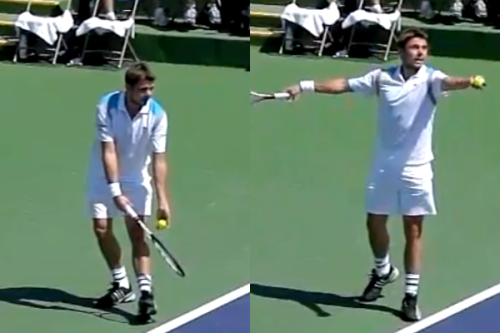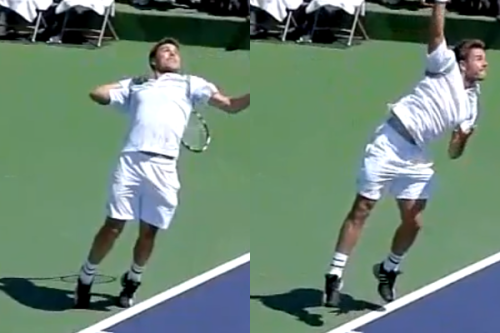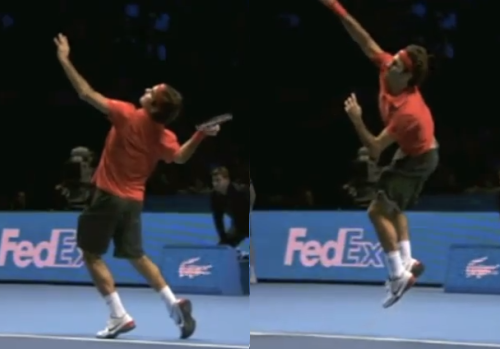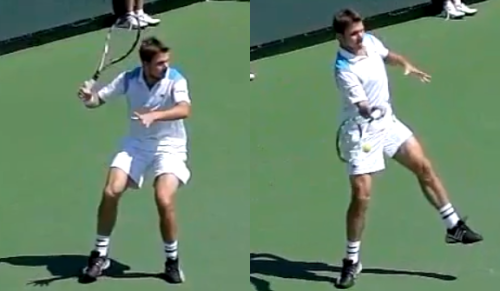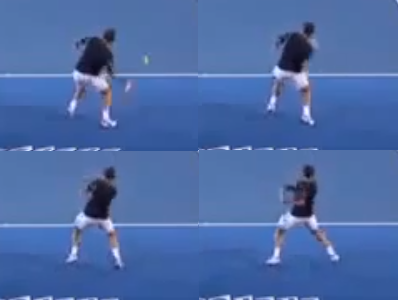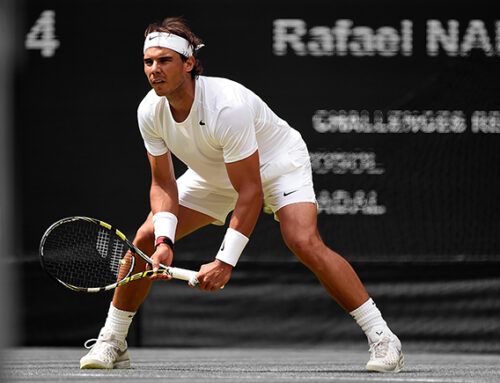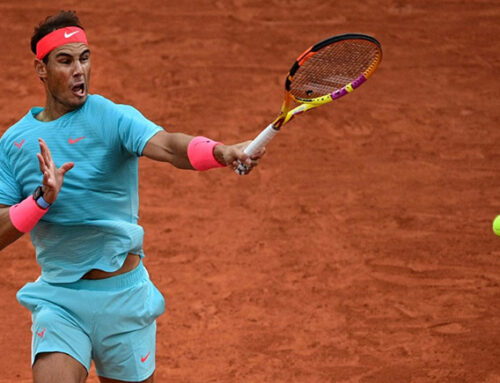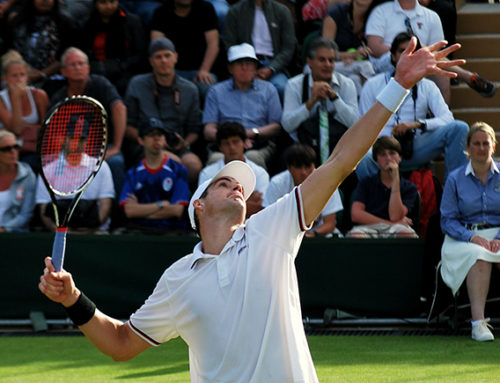The image of Stan Wawrinka weeping as he left court after the epic five-set match with Novak Djokovic are seared into the brains of many viewers as much as the scintillating tennis both men played. In an age when most players roll over and play dead for the ‘big four’ (and truth be told for the top 5 given Ferrer’s record against players not named Nadal, Djokovic, Federer or Murray in the last two years), Wawrinka clearly came to play. Stan wasn’t just playing to avoid embarrassment as has become common against Djokovic – Wawrinka wanted to win. But Stan is hardly a household name outside of true tennis fans despite cracking the top 10 back in 2008 and winning an Olympic gold medal in doubles with Federer. Who is the man with the backhand? What makes his game tick and given the level of tennis he was able to bring against Djokovic on Rod Laver Arena, why haven’t we seen more of him on the big stage in recent years?
Background
In many ways Stan Wawrinka is a victim of timing. In another age he might be considered the greatest male tennis player in Switzerland’s history. But of course there is Roger Federer, and it is in Federer’s shadow that Wawrinka has played the majority of his tennis career. Born four years after Federer in 1985, Stanislas reached #7 in the world Junior rankings before turning pro full time (Federer, of course was ranked #1 in Juniors before he himself went pro). Turning pro at 17 in 2002, in just three years Wawrinka found himself ranked just outside the top 50. It was in 2008 however that he reached his peak to date, making the finals of a Masters series event in Rome and breaking into the top 10. Since then his results have been very up and down, hanging in and around the top 20 but not able to truly threaten at the big events. Let’s look at Wawrinka’s game and see why.
Serve
Stanislas has a good serve, but it is not without its flaws. He averages 7.6 aces per match to Federer’s 8.3, but more than Murray’s 7.2. He brings good velocity to his first serve, averaging between 120 and 125 mph but topping out in the mid-to-high 130’s. His second serve is respectably heavy and comes in around 95 mph. So what exactly is wrong with Wawrinka’s serve? For starters his first serve % is low – in 2010 it came in at a terrible 57%, 2011 saw a bump up to 61%, but in 2012 was a miserable 56%. On a pro tour with so many good returners, you simply can’t give them a crack at your second serve on almost 50% of the points. Here’s the technical breakdown of Wawrinka’s serve and why his % is so low.
The first issue for Stan Wawrinka is that his motion isn’t particularly smooth. His address position is fine – weight over the front foot, racket and hands positioned together. He shifts the weight to the back foot, another classic service motion element. However right as Stan separates his arms and begins his toss, he rocks his hips forward again and begins to step with his back foot. The issue here really is the combination of the two – especially considering that his step isn’t just forward but also slightly out to the side. Even to the untrained eye it just looks clunky. Looking at the actual biomechanics he’s shifting his weight, while changing his body alignment, while lifting one foot off the ground, while opening his hips slightly – and during all of this he has to try to toss the ball to a precise place in the air several feet above his head. Relentless practice can mitigate this somewhat but it remains unnecessarily complex and less than ideal.
Problem #2 comes when he does his knee bend. It is a minimal knee bend and is accompanied by a relatively small jump to contact. To put it in perspective I’ve put a picture of both Wawrinka and Federer side by side at contact. You can see how much higher off the ground Federer is, which improves the geometries of getting the serve in. Consider that Wawrinka is ‘only’ 6′ tall – another player who is 6′ who does minimal leg-drive on his first serve is Almagro, and Almagro puts up similarly poor first serve % number himself. In fact, their career numbers are almost identical – Almagro’s sits at 59% for Wawrinka’s 58%. Consider that Wawrinka’s career high ranking came in 2008 – the same year he posted his career high first serve %.
Here’s an image displaying Wawrinka’s leg drive and jump on a serve:
And for contrast here is a picture of Federer’s leg drive and jump on a serve:
Although the angles are different, the contrast should be quite clear – Federer gets considerably more height at contact. It is no surprise then that although only 1″ taller than Wawrinka, Federer’s career first serve % is 62% while Wawrinka’s stands at 58%.
Groundstrokes
Wawrinka’s backhand is world class. It is undoubtedly in the conversation for best one-handed backhand in the game today. Given that an article later this week will be highlighting the technical differences between Wawrinka’s and Federer’s backhands, we will focus on Wawrinka’s forehand in this article. Which is fitting, since it is his weaker side and a major part of the reason he hasn’t had more sustained success at the big events.
Wawrinka hits with a semi-western grip and hits a pretty big ball off this side. He doesn’t lack for velocity or spin – Wawrinka’s issue is his consistency. Much as with the serve, there are small but important technical issues affecting his ability to make the shot as often as he should, and especially when it counts. Let’s look at some pictures.
Stan’s take-back is very clean and simple. There is no wasted movements, no unusual or unnecessary complications to the racket path. He gets good shoulder turn, closes the racket face off nicely at the back and keeps a fairly smooth, circular backswing. He gets the ball out nicely in front for contact, and clears the racket head across the body well. So where is the problem exactly? In a word: hips.
One of the little ‘secrets’ of the great forehands in the game is in a sense how little of the power really comes from the legs. A common misconception I run into when coaching is this idea that pros jump to add power to their shot on the forehand. The reality is that they will sometimes jump in order to lower the contact point with the ball relative to their own shoulders. Jumping complicates the timing of the stroke, and makes stability with the hips harder to achieve. If you jump while holding your hand you, you see (obviously) that your hand goes up with you. Put a racket in your hand, and the same upward translation occurs for the racket head also. Wawrinka has developed the unfortunate habit of jumping unnecessarily on his forehand side. He doesn’t do it all the time, and mostly when he hits a forehand with relatively little movement beforehand. It is a small movement, sometimes difficult to notice with the naked eye but it is there nonetheless. When Stan is playing well, feeling his groove his forehand is good. When he’s off, he can rack up unforced errors off that side – and the irony is that the balls he seemingly randomly misses off his forehands are often the ones that seem the easiest – middle of the court shots with little lateral movement beforehand.
In the four-image sequence above, we can see Wawrinka hitting a rally forehand in his match against Djokovic at the 2013 Australian Open. While the image quality isn’t the best, you can see the definite weight shift up and across of Wawrinka through the forehand as he hits it – except the ball is barely above his waist! He hit his forehand absolutely fantastically during the match this sequence is from – 26 of his 47 winners in the match came off that side – but this was Wawrinka playing the match of his life.
As mentioned above, Wawrinka’s one-handed backhand is the cream of the crop. Along with Gasquet, Almagro and Federer he is in the discussion for the greatest one-handed backhands of his generation, if not all time. He can hit with power off that side, handles the high ball well, and can hurt his opponents both cross court and down the line. Wawrinka has a good slice (albeit not at the level of Federer) and while his backhand side generally can’t dictate play for an entire point the way some players can with a big forehand, he is more than capable of ending a point off that side even against the run of play.
The Intangibles
So if all we can really pinpoint in Wawrinka’s technique are a couple of small (albeit important) problems, what’s the deal? Nadal has his flaws, and has 11 slams to his name. Why can’t Wawrinka bridge that gap and consistently challenge the top guys and be a part of the conversation? Is it his agility? Partly. While he’s certainly fit and strong, he doesn’t have the raw footspeed on the court that players like Federer and Nadal bring. Is it his conditioning? Partly. He’s fit (Wawrinka’s career record in five setters is 19 wins, 13 losses), but there was a definite divide between him and Djokovic at this year’s Australian Open. In fact watching match point from that match you can see his inability to break properly at Djokovic’s passing shot. As for the rest of it? It might be partly psychological – playing your entire career in Roger Federer’s shadow is hardly going to build you with a sense of destiny for greatness that players like Djokovic and the others carry with them. Wawrinka has ‘supporting cast’ written all over him rather than lead actor. His greatest tennis achievement came with Roger Federer as his doubles partner (the Olympic gold in Beijing) and you’d be hard pressed to find a tennis fan who doesn’t give Federer the lion’s share of the credit for that win.
The last factor is truly intangible. That intuitive sense of the right shot to hit in the right moment. Not just when you’re playing well, but when nothing is working. Players have an odds calculator in their head – a little computer that instantaneously inputs their court position, difficulty of the incoming ball, the position of their opponent and the capabilities of the stroke they are about to hit the ball with – and picks out the best shot for the situation. Not infallibly to be sure, and therein lies the rub. The great players do this a little better, a little faster, and a little more consistently than their peers. For someone like Wawrinka, who honestly has all the shots, shot selection can be the big difference maker. We need only have watched the Ferrer-Almagro fiasco for a perfect example. Three times Almagro stepped up to serve for the match against Ferrer. In all three games he tried to hit huge first serves and had a lot first serve % in those games as a result. In all three games he got broken, and lost in five sets. Watch Almagro play for twenty minutes and you see a man who can generate amazing pace with the ball seemingly with little effort. He has the tools, but his poor decision making has trapped him just inside the top 10.
The Future
What does the rest of the year hold for Wawrinka? That largely depends on how he responds to the loss to Djokovic. He played the #1 player in the world to a standstill, and frankly were it not for the bad line call on break point in the 5th, he probably would and should have won the match. Wawrinka will likely do one of two things. He will realize how close he was, how good he truly is, and tackle the rest of the year with the belief that he can play with the best. Or that match will serve as a brief moment of glory before he falls back down to his average level which will see him play out his career between 10 and 20 in the world. The reality is that he has a technically superior game to many of the players higher than him, and truth be told there’s only a small handful in the top 10 who are technically superior to him. Something else is holding him back and it might just be that playing a match like that against the #1 in the world on a big stage pushes him over the edge. Stan is only 27 years old and has probably two more years of peak-level tennis ahead of him. The next two months will largely set the tone for the rest of his career, and determine who he is seen when the book closes on his retirement.
